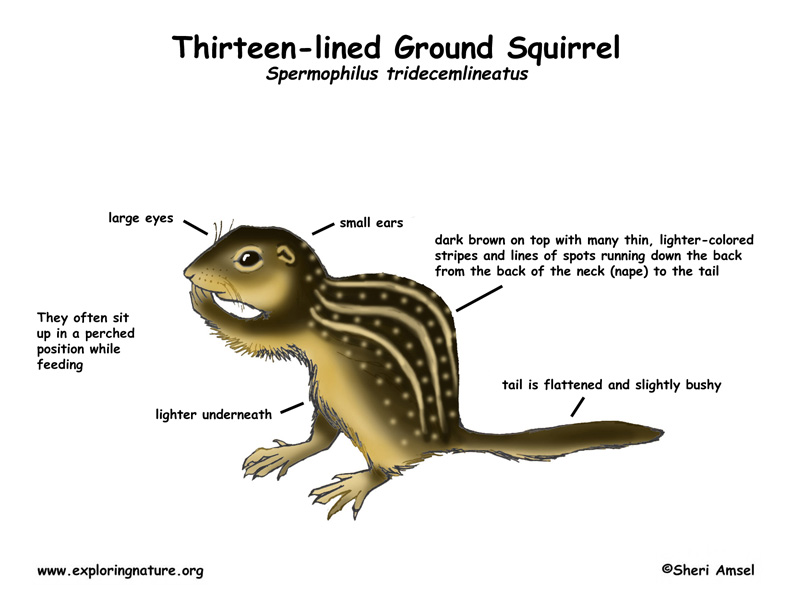

They were historically found on the short-grass prairies of central temperate North America (central U.S. through southern Canada), but have expanded into other states that have land cleared for development.
They live on short-grass prairies and in open areas developed by humans, like pastures, parks and golf courses. They need open land and sandy soil for their burrows.
Because of their small, thin body-size, tail shape and stripes, they are sometimes mistaken for large chipmunks. The thirteen-lined ground squirrel is larger than a chipmunk, reaching more than a foot long including the tail – though they can be smaller. They weigh about a quarter of a pound (4-ounces) and have small ears and large, dark eyes. They are dark brown on top with many thin, lighter-colored stripes and lines of spots running down the back from the back of the neck (nape) to the tail. They are lighter underneath. The tail is flattened and slightly bushy.
They are active during the day (diurnal) and on warm, sunny days are often seen sitting up in a “perched” position. They are territorial and though many may be seen living near each other, they are not communal. They live, raise young and hibernate through the winter in their own shallow burrows. They have a piercing alarm call to warn of approaching predators.
They prefer to eat seeds, but will also eat plants, roots, insects, spiders, eggs and even dead animals (carrion). They are omnivores and will store food in their burrows.
They are eaten by snakes, hawks, fox, coyote and other carnivores.
Females are pregnant for 1 month (gestation) and have one litter a year of about 8 young that they nurse for 6 weeks. Most are eaten by predators.
They can live for up to 8 years in the wild if they survive their first season. They are listed as Lower Risk - Least Concern.
Kingdom: Animalia
Phylum: Chordata
Subphylum: Vertebrata
Class: Mammalia
Order: Rodentia
Suborder: Sciuromorpha
Family: Sciuridae
Subfamily: Xerinae
Genus: Spermophilus
Species: Spermophilus tridecemlineatus
When you research information you must cite the reference. Citing for websites is different from citing from books, magazines and periodicals. The style of citing shown here is from the MLA Style Citations (Modern Language Association).
When citing a WEBSITE the general format is as follows.
Author Last Name, First Name(s). "Title: Subtitle of Part of Web Page, if appropriate." Title: Subtitle: Section of Page if appropriate. Sponsoring/Publishing Agency, If Given. Additional significant descriptive information. Date of Electronic Publication or other Date, such as Last Updated. Day Month Year of access < URL >.
Amsel, Sheri. "Ground Squirrel (Thirteen-lined)" Exploring Nature Educational Resource ©2005-2024. March 25, 2024
< http://www.exploringnature.org/db/view/488 >

